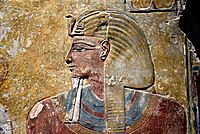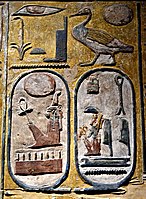User:Lightfootcrytpkeeper/New sandbox
Note For Student Editor: I am working on formatting this page, along with adding more to each section. Beyond that, much of what I edited is not in my sandbox, but on the actual wikipage itself. Please find my edits in the edit history of the wikipage.
Tomb KV17, located in Egypt's Valley of the Kings and also known by the names "Belzoni's tomb", "the Tomb of Apis", and "the Tomb of Psammis, son of Nechois", is the tomb of Pharaoh Seti I of the Nineteenth Dynasty. It is one of the best decorated tombs in the valley, and is one of the largest and deepest tombs in the Valley of the Kings[1]. It was discovered by Italian archaeologist and explorer Giovanni Battista Belzoni on 16 October, 1817.
Design[edit]

Previously considered the longest tomb in the valley until the discovery of the Tomb of the Sons of Ramesses II, at 137.19 meters (450.10 feet),[2] it contains very well preserved reliefs in all but two of its eleven chambers and side rooms. Author Kent R. Weeks writes that the inclined length of the tunnel is roughly 227m, with a horizontal length of 194. The floor is roughly at an angle of 34-36°[3]. The Tomb is of a rectangular cross section, made of Esna shale, which engineer Ayman Hamed claims is incredibly dangerous, and would be unadvisable in our modern times to construct with, especially in the tombs already fragile state[4].
A shaft was cut into the floor of chamber E, its purpose unknown[5].
An unusual addition to the tomb is still being excavated, known as Corridor K. Corridor K leads away, into the mountainside, from beneath the location where the sarcophagus stood in the burial chamber. The tunnel has not been properly excavated, as much of the tunnel has been filled with debris. Probing projects into the tunnel started around 2001; according to the Theban Mapping Project, "A project to geophysically explore the corridor was approved by the Supreme Council of Antiquities"[6]. The results published above by Ayman Hamed in 2013 show that the tunnel extends deeper down below the tomb, but have no archaeological findings of note.[3]
Decoration[edit]
(Editors note: This section will be expanded.)
One of the back chambers is decorated with the Opening of the mouth ceremony, which shows the Egyptian belief that a magic religious ceremony would open the lungs and throat of the mummy, allowing them to breathe in the afterlife. Considered a very important religious ceremony, a semi-complete depiction of this ritual allows us more in-depth view of the pantheon of practices undertaken to ensure safe passage into the afterlife[7]. Further into the tomb are numerous depictions of King Seti with numerous Gods. Chamber F depicts images of Seti with Hathor, Horus and Neith[8], along with intact mural examples of the Book of Gates. The entry corridors (Corridors B-D) are heavily decorated with symbols of the Pharaoh, like those of Ma'at and a list of Set's royal names and epithets[9].
Parts of the tomb ceilings have been painted with gold stars on a deep blue sky, a common motif in temples and tombs in Egypt. Numerous rooms in Seti's tomb utilize the motif.
Archaeology and conservation[edit]

It was first discovered by Giovanni Battista Belzoni[10] on 16 October 1817. Upon entering the tomb, Belzoni found the wall paintings in excellent condition with the paint on the walls still looking fresh, and some of the artists' paints and brushes still on the floor.[11] The tomb became known as the "Apis tomb" because when Giovanni Belzoni found the tomb a mummified bull found in a side room off the burial hall.[4]
In July of 1828, the Franco-Tuscan Expedition lead by Jean-François Champollion (translator of the Rosetta Stone) and assisted by Ippolito Rosellini did intense mapping of the tomb, while also damaging parts of murals and walls irreplaceably[3] following floodwaters that filled the improperly sealed tomb after heavy rains; large pieces of the walls and the ceiling fell following the expansion of the stone[3]. Jean-François Champollion, removed a wall panel of 2.26 x 1.05 m (7.41 x 3.44 ft) in a corridor with mirror-image scenes during his 1828–29 expedition. Other elements were removed by his companion Rossellini or by Karl Richard Lepsius in the German expedition of 1845. The scenes are now in the collections of the Louvre in Paris, the Egyptian Museum in Florence, the Neues Museum in Berlin.[12][13] Historian M.H. Carter wrote of the Franco-Tuscan Expedition that "in reading through Belzoni's interesting account of his discovery of this tomb in 1817, and his description of its beautifully decorated walls and ceiling, one cannot but think that it must then have been in a perfect condition"[3]. Carter also worked to restore the tomb, improving dykes and repairing walls, along with restoring reliefs and paintings. Unfortunately, improper excavation, vandals who hacked away parts of the paint, and soot from torches has damaged much of the main halls[3]
The body identified as Seti's mummy was not found in his coffin upon Belzoni's discovery of the tomb, but rather in the royal cache DB320 amongst 36 other mummies[14]. His coffin (perhaps the inner or secondary coffin) was heavily damaged, as was his mummy. It's been postulated that priests of numerous dynasties attempted restorations of both his tomb and his coffin, but was finally moved in the Year 11 of Shoshenq I where he was finally moved to cache DB320[15].The outer layer of the sarcophagus of Seti I, removed on behalf of the British consul Henry Salt, is located in the Sir John Soane's Museum in London since 1824.
A number of walls in the tomb have collapsed or cracked due to excavations in the late 1950s and early 1960s causing significant changes in the moisture levels in the surrounding rocks.[16][17]
Facsimiles of two rooms from the tomb, the Hall of Beauties and Pillared Hall J, were made by Factum Foundation for Digital Technology in Conservation in 2017.[18]
Gallery[edit]
-
Pharaoh Seti I before Osiris, wall painting from KV17, Hall J, Pillar B, side a. Neues Museum
-
Pharaoh Seti I, detail of a wall painting from the Tomb of Seti I at the Valley of the Kings. Neues Museum
-
Birth and throne cartouches of pharaoh Seti I, from KV17. Neues Museum
References[edit]
- ^ "KV17 (Tomb of Seti I) - Madain Project (en)". madainproject.com. Retrieved 2023-02-20.
- ^ Bossone, Andrew (April 17, 2008). "Pharaoh Seti I's Tomb Bigger Than Thought". National Geographic News. Retrieved 2008-04-19.
- ^ a b c d e f Hamed, Ayman (October–December 2013). "Re-Excavation Of Seti First Tomb, KV17, Luxor, Egypt" (PDF).
{{cite web}}: CS1 maint: date format (link) - ^ a b "KV17 (Tomb of Seti I) - Madain Project (en)". madainproject.com. Retrieved 2023-02-21.
- ^ "Sety I | Theban Mapping Project". thebanmappingproject.com. Retrieved 2023-02-21.
- ^ "Sety I | Theban Mapping Project". thebanmappingproject.com. Retrieved 2023-02-21.
- ^ "Opening of the Mouth". www.ucl.ac.uk. Retrieved 2023-02-21.
- ^ "Sety I | Theban Mapping Project". thebanmappingproject.com. Retrieved 2023-02-21.
- ^ "Sety I | Theban Mapping Project". thebanmappingproject.com. Retrieved 2023-02-21.
- ^ Dunn, Jimmy. "The Tomb of Seti I". Retrieved March 7, 2014.
- ^ Romer, John; Romer, Elizabeth (1993). The Rape of Tutankhamun. Michael O'Mara Books Limited. p. 107. ISBN 1-85479-169-9.
- ^ Coppola, M.; Bracci, S.; Cantisani, E.; Magrini, D. (2017). "The Tomb of Seti I (KV17) in the Florence Egyptian Museum. Integrated Non-Invasive Methods for Documentation, Material History and Diagnostics". International Archives of the Photogrammetry, Remote Sensing and Spatial Information Sciences. XLII-5/W1: 127–135. Bibcode:2017ISPAr42W4..127C. doi:10.5194/isprs-archives-XLII-5-W1-127-2017.
- ^ Hornung, Erik (2001). "The Tomb of Seti I". In Weeks, Kent R. (ed.). Valley of the Kings: The Tombs and Funerary Temples of Thebes West. VMB Publishers. pp. 195–211. ISBN 9788854009769.
- ^ Bart, Anneke (2004). "The Mummy Cache Found In DB320".
{{cite web}}: CS1 maint: url-status (link) - ^ "View 19'th Dynasty Royal Mummies from DB320 & KV35". members.tripod.com. Retrieved 2023-02-21.
- ^ Romer, John; Romer, Elizabeth (1993). The Rape of Tutankhamun. Michael O'Mara Books Limited. pp. 25–30. ISBN 1-85479-169-9.
- ^ Romer, John; Romer, Elizabeth (1993). The Rape of Tutankhamun. Michael O'Mara Books Limited. pp. 49–50. ISBN 1-85479-169-9.
- ^ Foundation, Factum. "Factum Foundation :: The Tomb of Seti: recording and facsimile". www.factumfoundation.org. Retrieved 2020-04-08.
- Reeves, N. & Wilkinson, R. H. The Complete Valley of the Kings, 1996, Thames and Hudson, London.
- Siliotti, A., Guide to the Valley of the Kings and to the Theban Necropolises and Temples 1996, A.A. Gaddis, Cairo.
- Belzoni, Giovanni, Narratives of the operations and recent discoveries in Egypt and Nubia:... 1820



